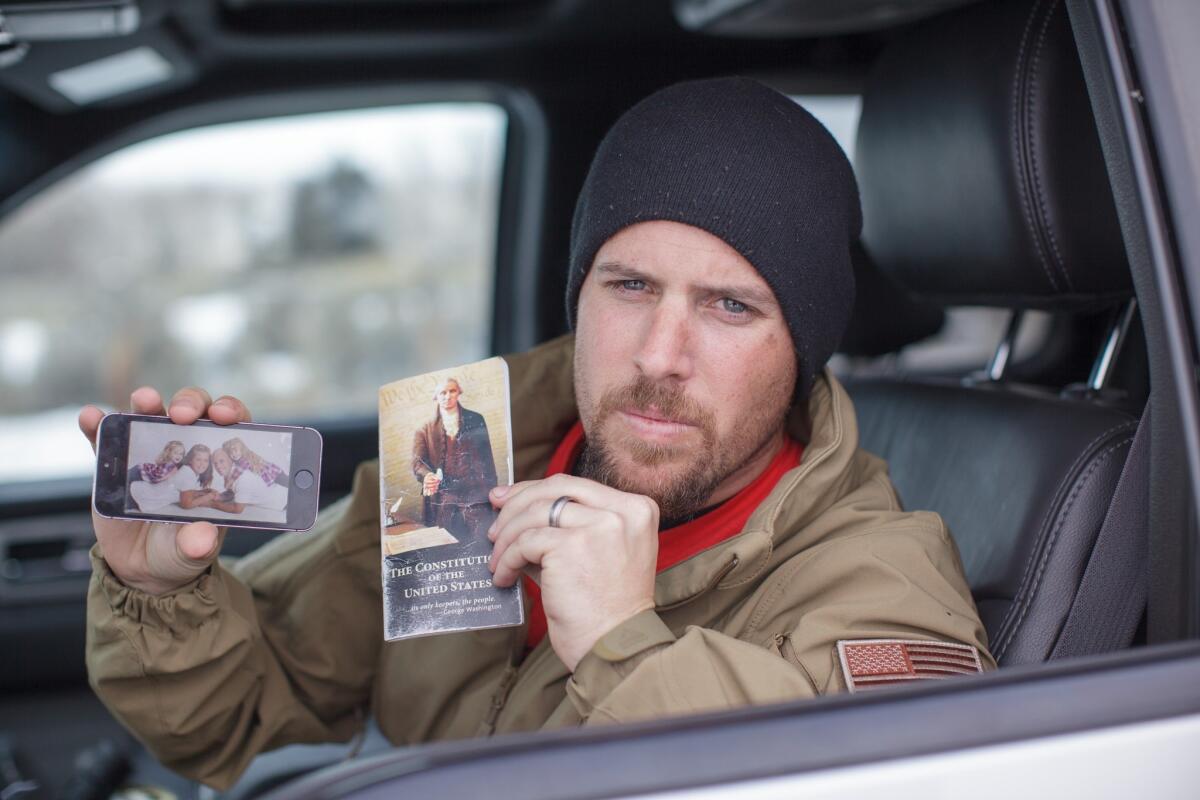Op-Ed: Are the activists occupying Malheur National Wildlife Refuge in Oregon ‘terrorists’?

Jon Ritzheimer, 32, shows a family picture on his phone and a copy of the Constitution to the media at the Malheur National Wildlife Refuge headquarters in Oregon on Jan. 4.
- Share via
After an armed group drew attention to an Oregon land-use dispute by seizing a building in the Malheur National Wildlife Refuge on Saturday, the government’s reaction seemed almost low-key. The White House called the protest “a local law enforcement matter” and said the Federal Bureau of Investigation was merely “monitoring the situation and offering support.” Although the police haven’t revealed much about their plans, it looks as though they’re willing to wait out the occupiers rather than charge in with guns blazing.
If so, that’s good news for anyone who hopes this situation can be resolved peacefully. Sadly, not everyone seems to share that hope.
The question of what qualifies as terrorism is hotly contested, but the most compelling definitions hinge on whether the perpetrators target civilians.
The Internet has been overflowing with demands for the protesters’ blood. Search Twitter for “Oregon” and “drone strike” and you’ll find tons of people proposing to give the Malheur activists the Abdulrahman Awlaki treatment. TV host Montel Williams tweeted that the authorities should “put this down using National Guard with shoot to kill orders.” “I hope they pull a M.O.V.E. on those terrorists in Oregon,” wrote the author Jess Nevins, alluding to a black militant group whose Philadelphia headquarters were bombed by the police in 1985, killing 11 people and destroying dozens of homes.
Nevins wasn’t the only one to use the word “terrorists.”
“Heavily armed domestic terrorists have occupied a wildlife preserve in Oregon,” military historian Tom Mockaitis wrote in the Huffington Post. In the Daily Beast, columnist Sally Kohn complained about “the federal government’s hyper-passive response to such flagrant acts of menacing and threats of domestic terrorism.” Former Homeland Security official Juliette Kayyem, now the host of a podcast called Security Mom, declared on CNN’s website that the occupation in Oregon is terrorism “by any definition.”
Really? By “any” definition?
The question of what qualifies as terrorism is hotly contested, but the most compelling definitions hinge on whether the perpetrators target civilians. The political philosopher Tony Coady, for example, says that terrorism involves “intentionally targeting noncombatants with lethal or severe violence for political purposes,” while Peter Simpson, another academic, refers to “acts of indiscriminate violence directed at civilians or nonhostile personnel.”
That framework would certainly include Islamic State’s slaughter of 130 people in Paris in November. It would also include the racist massacre of nine worshipers at a Charleston, S.C., church last summer. But breaking into an unoccupied building?
The occupiers do have guns, and they have said they’re willing to use them if the cops come storming in. Yet they have no hostages, they haven’t fired at anyone, and if they do fire they will almost certainly not aim at a civilian but at someone professionally charged with removing them from the premises. You can call that a lot of things, but it’s absurd to call it terrorism.
Not everyone invoking the T-word has called for a quick assault. Kayyem, for example, noted that time is on the feds’ side and that it would be dumb to send in a SWAT team now.
Nonetheless, the word’s general effect is to inflame emotions. There’s a reason it has been applied to everyone from hackers to nonviolent environmentalists: That makes it easier to justify a harsh crackdown.
If there’s a legitimate frustration beneath the boiling rhetoric, it’s that a double standard is at work. Countless commentators have contrasted the government’s cautious response to the Oregon occupation with the quick-draw cop in Cleveland who shot Tamir Rice, a 12-year-old boy who had been playing with a toy gun in a city park. And indeed, Tamir suffered an abominable injustice, as have many other victims of excessive police force, from Eric Garner to Walter Scott. When the point of the comparison is to wish the police would use care and caution more often, the tweeters are absolutely right. But when the point is to complain that the government isn’t moving more swiftly in Oregon, they’re absolutely wrong. The killing of Tamir Rice shouldn’t be a model for anyone.
Conflicts like this are haunted by the 1990s sieges in Waco, Texas, and Ruby Ridge, Idaho, where the feds’ confrontational tactics had lethal consequences.
After those disasters, the government changed its strategy. In 1996, for instance, Atty. Gen. Janet Reno was more restrained against a Montana group called the Freemen, announcing that the FBI wanted “no armed confrontation, no siege, no armed perimeter and no use of military assault-type tactics or equipment.” (There’s a good chance she didn’t just have the Freemen’s potential for violence on her mind: Militia leaders around the country had declared that they’d intervene if they felt the feds stepped over the line, turning a local conflict into a larger one.) The incident ended peacefully.
If the authorities are looking to their Freemen playbook now, it’s a sign they remember some of the lessons of the 1990s. Not everyone can say the same.
Jesse Walker, the books editor at Reason magazine, is the author of “The United States of Paranoia,” a history of American conspiracy theories.
Follow the Opinion section on Twitter @latimesopinion and Facebook
MORE FROM OPINION
Obama’s teary, yet mild, gun reform
How to survive El Niño like an Angeleno
Another homelessness plan emerges. Yay. Now let’s see some follow-through.
More to Read
A cure for the common opinion
Get thought-provoking perspectives with our weekly newsletter.
You may occasionally receive promotional content from the Los Angeles Times.









